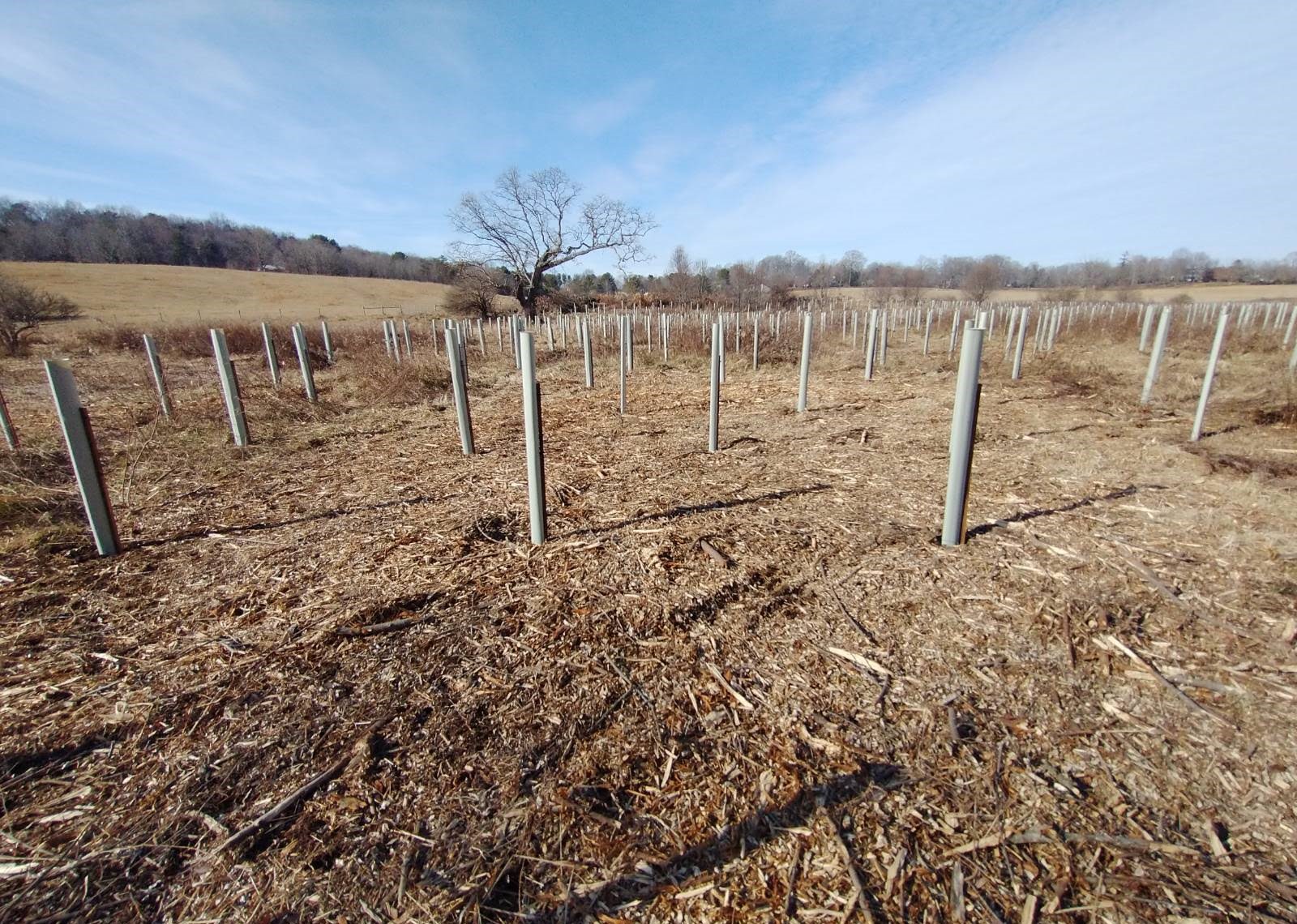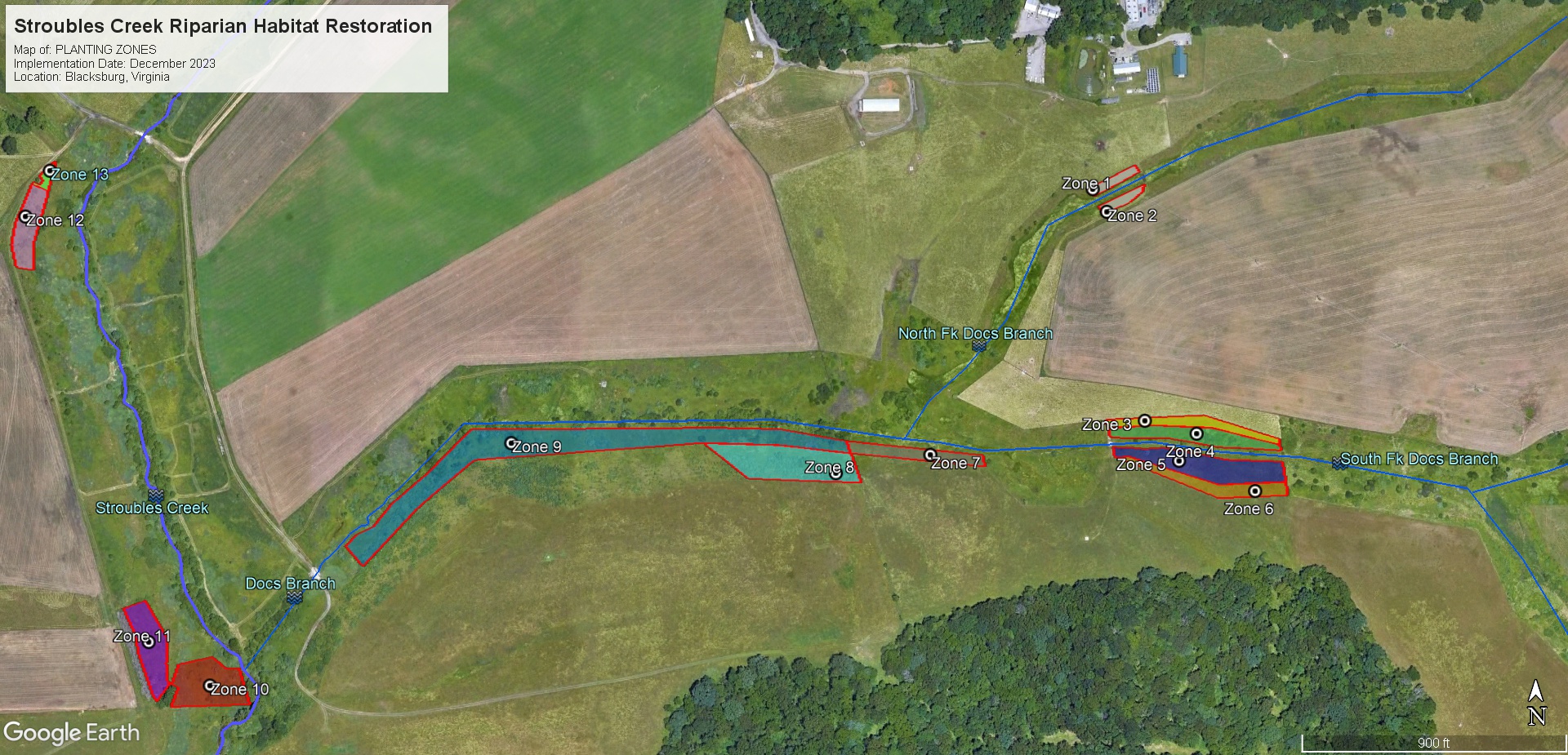The Stroubles Creek, VA Riparian Reforestation Project implemented agricultural best management practices (BMPs) by planting 3,900 trees and shrubs across 30 native species along Stroubles Creek and Docs Branch, a tributary of Stroubles Creek. Nine acres of native woodland riparian buffers (strips of vegetation- trees, shrubs or grass – planted next to streams or other waterbodies) were planted at a density of 435 trees per acre. These targeted restoration sites, located on Virginia Tech and Virginia Tech Foundation property, are within the federally designated impaired waterway stream reach.
Native trees planted in a 10’x10′ spacings using 100% certified biodegradable materials. The tubes will be reused again and again until their service life is up and fungi begin to break them down. Photo Cully Hession, VT BSE

These selected restoration sites are all located in either disturbed riparian areas or wetlands and floodplains regularly inundated with stormwater runoff.
A bit of backstory: Upon the arrival of non-indigenous settlers, the old-growth riparian forests were clear-cut, and the land was made into pasture for livestock. Many of these sites were fenced off from livestock grazing at various stages between the 1990s and 2017. Now, Virginia Tech’s campus and the Town of Blacksburg are rapidly expanding and these sites are experiencing a rapid influx of non-native, invasive vegetation such as privet, autumn olive, multiflora rose, and tall fescue. There are few native trees able to establish on the sites, even those fenced off by livestock in the 1990s.
The future of the land: Within these areas, the future points to a rapid transition from agricultural use to urban use in the next decade. This project is designing and implementing the future urban forest of the fastest-growing urban center in the New River Valley of Southwest Virginia.
This project addressed the lack of riparian vegetation, which was a leading contributor to the stream system conditions that led to the Stroubles Creek’s impairment listing as determined by the Virginia Department of Environmental Quality during a study to determine the causes of the Stroubles Creek impairment.
The restoration of the riparian buffers will improve the resiliency of the Stroubles Creek stream system so it will better be able to absorb stormwater runoff from the expanding urban footprint in the watershed. This improves the resiliency of countless communities downstream to the increased risk of catastrophic flooding. The plantings will also enhance the quality of water, lower water temperatures over time, provide forage and habitat for aquatic and terrestrial wildlife, and connect fragmented ecosystems to improve wildlife safe wildlife migration corridors.
This site will serve as an ongoing living lab for student courses and university research. New River Conservancy works directly with over ten courses at Virginia Tech that help play a part in project implementation, monitoring, and maintenance.
The result is a step forward in the watershed’s ecological, economic, and social sustainability. Restoring native riparian buffers is the most reliable and cost-effective approach to improving water quality, managing stormwater runoff, and connecting fragmented ecosystems for wildlife. Ensuring the health of a community’s watershed is the foundation of economic, ecological, and social sustainability and resiliency for all the inhabitants within the watershed. This project will give roots to resilient urban forests of the future in a rapidly expanding urban landscape around Blacksburg, VA.
This project was made possible through a broad coalition of entities including New River Conservancy, Virginia Department of Forestry, Virginia Tech Biological Systems Engineering, Stroubles Creek Coalition, Virginia Tech Office of Sustainability, Virginia Tech Site and Infrastructure Development, Virginia Department of Environmental Quality, US Environmental Protection Agency, and Virginia Environmental Endowment.
Map of full project footprint in Stroubles Creek Riparian Habitat Restoration Project.


